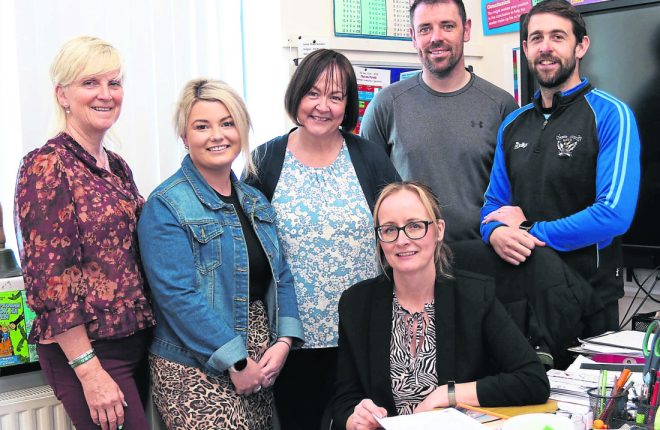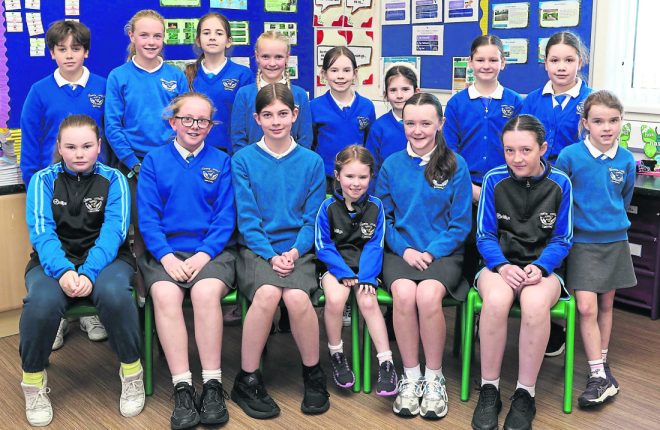By Róise Collins
ONE year after their transition to a Gaelscoil, a small school in west Donegal is continuing to work tirelessly to promote the benefits of Irish-medium education, as part of a heartfelt effort to revive the native language within their community.
Keadue National School, which is situated between the fishing villages of Burtonport and Kincasslagh, was initially established as an Irish language school in 1903. However, over fifty years ago, they transitioned to teaching in English.
Last year, after a lengthy five-year process which was delayed due to the pandemic, Scoil an Aingil Choimhéadaí successfully reverted to teaching exclusively in Irish.
The transition was part of Scéim Aitheantais na Gaeltachta, a government initiative introduced back in 2017.
Current principal Anne Marie Uí Icí credits much of the hard work to her predecessor, Maire Ní Chómhaill, who has since retired.
“She had carried out a lot of work with the oral Irish, so really, she had started the transition herself before the scheme came about. So when it was announced, it was very natural for the school to sign up for it,” Anne Marie explained.
While the staff are delighted to bring Irish back to the small community, the journey hasn’t been without its hurdles. With just 15 pupils, the school faces unique challenges compared to other Gaelscoileanna as Irish is not the primary language spoken in Keadue.
“We are delighted that Irish is back. Now our focus is on promoting that we are here, and that we are Irish medium, because a lot of people still don’t know,” Anne Marie told the Donegal News.
Anne Marie acknowledged the hesitation some local parents have toward Irish-medium education, often rooted in their own negative experiences learning Irish in school. But Anne Marie is determined to change that mindset.
“They just don’t understand the advantages of raising your child bilingually. Your brain is wired different when you’re bilingual,” she said.
She explained that Irish-medium education not only enhances language and literacy skills but also strengthens student’s problem-solving and mathematical abilities.
Research has shown that bilingual students will also have higher results in standard tests for both literacy and numeracy.
Beyond academia, being bilingual supports creativity, confidence and a strong sense of cultural identity. Students with Irish are also well-prepared for further education and a wide range of career opportunities both in Ireland and Europe.
“It’s kind of a no-brainer and I don’t know how to say that in better terms,” she laughed.
The school has already seen students transfer from English-medium schools with no difficulties in adapting.
“Their brains are like wee sponges” Anne Marie explained.
She stressed that parents do not have to be Irish speakers themselves to support their child’s education.
“So many pupils come from households where Irish isn’t their first language or sometimes isn’t spoken at all.”
The school have also welcomed a number of students from Ukrainian students, who just within a few years have fully immersed themselves in the Irish language.
According to research, the most effective way to learn a language is through full immersion, and these students are a testament to that.
During lunch, you can hear them chatting away as gaeilge with their classmates in the playground.
Ann Marie also shared her personal journey. Born in Glasgow, she moved to Gortahork at the young age of seven with little more than a cúpla focal. She recalled her first day at school in Caiseal Na gCorr, a small school in the heart of the Gaeltacht, where she sat amongst the other students speaking fluently in Irish and quietly vowed to herself she’d learn it too.
That early promise sparked a deep love and appreciation for the language, and she eventually pursued a degree in Irish. But like many who learn Irish later in life, she faced her fair share of setbacks.
“I remember when I started speaking Irish to people, they’d dismiss me because I was born in Scotland. They just assumed I couldn’t speak it.”
“It took me a while to build the confidence to say ‘Actually, I can speak Irish’, I might not have the same blás but I actually can.
“I couldn’t give a hoot now, I speak Irish to everybody,” she laughed.
She is now determined to ensure nobody in the community ever feels excluded from using the language. The school offers weekly Irish language classes for parents and community members looking to learn or brush up on their conversational skills.
These classes have been a huge success. She is now meeting parents at the school gates who wouldn’t have spoken a word of Irish before who are now confidently chatting away as Gaeilge.
These small changes, she believes, are key to transforming their community.
“Were just trying to make those little changes, to get people open up to the whole idea and hopefully revive the language within the community.”
The schools board of management have also been active, hosting events like art classes, camps and talent shows, encouraging the local community to come engage with the school and their mission.
Looking to the future, the school hopes to establish a Naíonra to help feed into the primary school and boost their numbers.

Scoil an Aingil Choimhéadaí, Keadue principal, Anne Marie Uí Icí (seated) with staff members, from left, Maire Ní Chómhaill, Jaymee Ní Mhúirí, Joanna Ní Shearcaigh, Micheal Mac Giolla Chomhaill, and Declan Ó Fríl. Photos: Eoin Mc Garvey

The fifteen pupils at Scoil an Aingil Choimhéadaí, Keadue.

Scoil an Aingil Choimhéadaí, Keadue.










